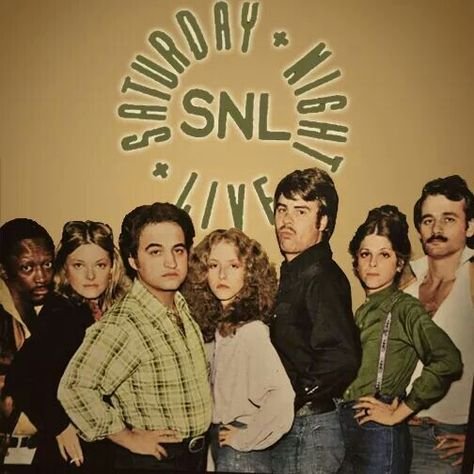50 Years of Saturday Night Live: The Show That Became the Culture
By Natalie McCarty
There are few institutions in American entertainment as enduring and influential as Saturday Night Live. More than just a comedy show, SNL is a living, breathing time capsule—a weekly reflection of our culture, our politics, our absurdities, and our humanity.
For five decades, SNL hasn’t merely responded to the zeitgeist, it has defined it. The show has given us catchphrases that become part of everyday language, impressions that become more famous than the people they mock, and performances that feel more real than reality itself. But, beyond that, it has created superstars, dismantled political careers, shaped public discourse, and left an imprint on everything from television and film to advertising and music. Whether you wish to admit or not, SNL is one of the most revolutionary forces in American culture.
Image Sourced through Pinterest
It’s no secret that when Saturday Night Live first aired on October 11, 1975, no one knew whether it would last a full season, let alone 50 years. Created by Lorne Michaels, the show was an experiment of an unpredictable mix of sketch comedy, political satire, and live music, all performed by an ensemble of young comedians. At a time when network television was dominated by formulaic sitcoms and variety shows, SNL felt raw, anarchic, and dangerous. It spoke directly to a generation disillusioned by Watergate and the Vietnam War, offering a new kind of comedy: one that was sharp, irreverent, and unafraid to take risks.
The original cast—later dubbed the Not Ready for Prime Time Players—included future legends like Chevy Chase, John Belushi, Dan Aykroyd, Gilda Radner, Jane Curtin, Garrett Morris, Laraine Newman, and Bill Murray (who joined in season two). Their chemistry, combined with a rebellious spirit, set the tone for what SNL would become.
Image Sourced through Pinterest
From the very beginning, the show broke the mold. Chevy Chase’s bumbling, pratfall-heavy impression of Gerald Ford made presidential impersonations a cornerstone of SNL’s satire. John Belushi’s Samurai Futaba character was both ridiculous and weirdly mesmerizing. Gilda Radner’s Roseanne Roseannadanna and Emily Litella became instant fan favorites. Yes, the show mocked pop culture, but it also was pop culture.
Image Sourced through Pinterest
Through the years, SNL has remained an unparalleled force in shaping public perception. Politicians and celebrities alike have found themselves either elevated or eviscerated by the show’s spotlight.
The political satire of SNL has, at times, been so influential that it altered the way people viewed real-life figures. Dana Carvey’s impression of George H.W. Bush (“Not gonna do it!”) became so iconic that Bush himself eventually invited Carvey to the White House. Will Ferrell’s exaggerated take on George W. Bush—goofy, clueless, yet oddly likable—cemented an image that followed the president throughout his career. Tina Fey’s uncanny portrayal of Sarah Palin during the 2008 election (“I can see Russia from my house!”) was so spot-on that many people mistakenly believed Palin had actually said it.
Beyond politics, SNL has also played a crucial role in redefining celebrity personas. Justin Timberlake’s transition from boy band heartthrob to respected entertainer was solidified through his self-deprecating appearances on the show. Christopher Walken’s comedic legacy was cemented not through his films, but through his bizarre, unforgettable “More Cowbell” sketch. Tom Hanks, already a beloved actor, became even more of a national treasure through SNL characters like David S. Pumpkins
Image Sourced through Pinterest
One of SNL’s greatest contributions to entertainment is its role as a launching pad for comedic legends. The list of alumni reads like a Hall of Fame: Eddie Murphy, Bill Murray, Dan Aykroyd, Chevy Chase, John Belushi, Gilda Radner, Tina Fey, Amy Poehler, Will Ferrell, Kristen Wiig, Adam Sandler, Chris Rock, Maya Rudolph, Kate McKinnon, and dozens more.
In the ‘80s, Eddie Murphy saved the show from cancellation when ratings were plummeting. Will Ferrell dominated the late ‘90s and early 2000s with his absurd, high-energy characters. The Weekend Update desk has launched some of the sharpest comedic voices in the industry, from Dennis Miller and Norm Macdonald to Seth Meyers and Colin Jost.
SNL alumni have then gone on to shape comedy in broader ways. Lorne Michaels himself has had an outsized influence on modern entertainment, producing Late Night with Conan O’Brien, The Tonight Show, 30 Rock, and countless films starring former SNL cast members.
SNL simply IS the comedy industry.
Image Sourced through Pinterest
Part of what makes SNL so special is its unpredictability. Because it’s live, anything can happen, and, sometimes, the best moments are the ones that weren’t planned.
Ashlee Simpson’s infamous lip-sync debacle in 2004 became one of the most talked-about SNL moments of all time. Bill Hader’s Stefon character was so bizarre that even he couldn’t always keep a straight face. John Belushi’s Samurai Deli sketches had an element of chaos that could never be fully controlled. The show’s imperfections—flubbed lines, accidental laughter, unexpected ad-libs, breaking character—are part of its charm.
Image Sourced through Pinterest
Somehow, even after five decades, SNL still matters. Perhaps even more so than ever. Every Saturday night, it holds up a mirror to society, making us laugh, cringe, and sometimes even cry.
It has given us deeply emotional moments, ones of hope, joy, love, loss, and universal grief. It has provided healing through laughter during some of America’s darkest times, from the first episode after 9/11 to Dave Chappelle’s monologues following moments of national crisis.
Through all its ups and downs, Saturday Night Live remains the heartbeat of American culture. It is a testament to comedy’s power—not just to entertain, but to challenge, to satirize, to unite.
Fifty years in, it’s still live from New York. And we’re still watching.






